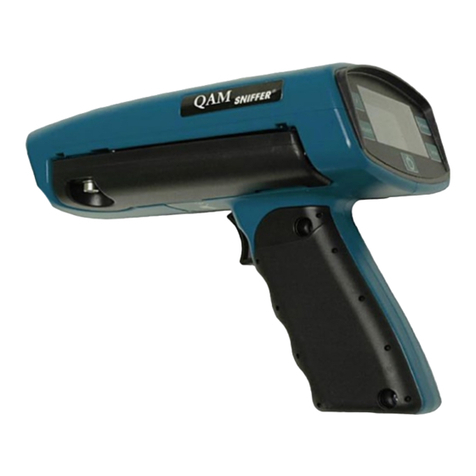
Sniffer Sleuth User’s Manual 1
Introducing Sniffer Sleuth
Sleuth is a hand-held signal leakage detection device. When programmed, Sleuth makes active
measurements on a chosen frequency and shows the results on a liquid crystal display (LCD). It
indicates detected leakage by receiving and processing a modulated carrier.
Sleuth can detect leaks at up to 500 feet with a sensitivity of -76 dBmV (0.4 µV/m), or -72 dBmV
(0.7 µV/m) if the Sniffer I.D. tag system is used. There are two models that differ only in their tuning
ranges: the model 100760-001, which operates in the range of 80 ~ 120 MHz in increments of 1 kHz,
and the Model 100760-002, which operates in the range of 120 MHz ~ 150 MHz in increments of
1 kHz.
Sleuth has Sniffer II/III and SnifferIDtone discrimination capability: it can be set to detect one or
both of two discrete “tag” signals injected into a television signal by a SnifferIDsignal source.
Sleuth operates in one of two modes: a “video” mode, in which Sleuth generates its own audio tone
based on the signal from a video sensing system; and a “Sniffer” mode, in which Sleuth amplifies a
received signal for its audio output (see Using Sleuth in the Field, Operating Modes). Muting
suppresses the audio output but not the readout displays. Sleuth also discriminates between signal
leakage and such non-signal RF radiation as power lines and burst noise.
Sleuth has a built-in dipole antenna, or can be adapted to work with a handheld dipole antenna. The
Docking Station adapts Sleuth for monopole antenna use. Sleuth can also be used with the GeoSniffer
for vehicle-based mapping of RF leakage. (See Using Sleuth with the Docking Station and Using
Sleuth with an External Antenna, and Setup Function Modes: External Antenna for details.)
When Sleuth’s dipole antenna is fully retracted and
stored normally, the unit has the functionality of a near-
field probe antenna. Common-mode reception enabled
by the folded antenna elements collapses the sensitivity
to a forward direction, increasing Sleuth’s near-field
isolation capability. The illustration demonstrates
Sleuth’s field of sensitivity in this way.
Rechargeable nickel-cadmium (NiCad) batteries are used to power Sleuth. Although intended for
hand-held operation. Sleuth can also be operated from a vehicle power system through the use of an
optional Docking Station. (See Using Sleuth with the Docking Station.)
The Sleuth battery is shipped with only a minimal charge and must be recharged
before operation. The Sleuth’s battery type requires 3 to 4 hours to recharge fully. See
the Getting the Most from Your Batteries pamphlet for more information.





























